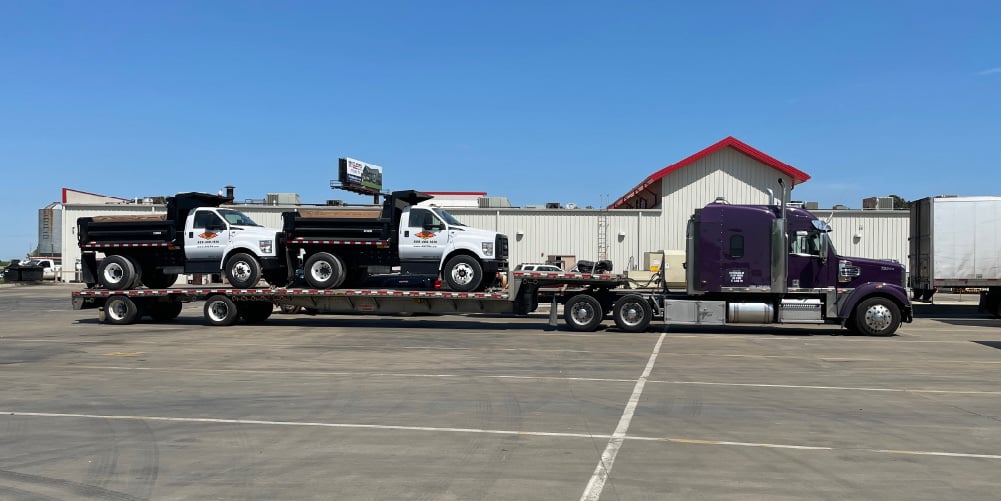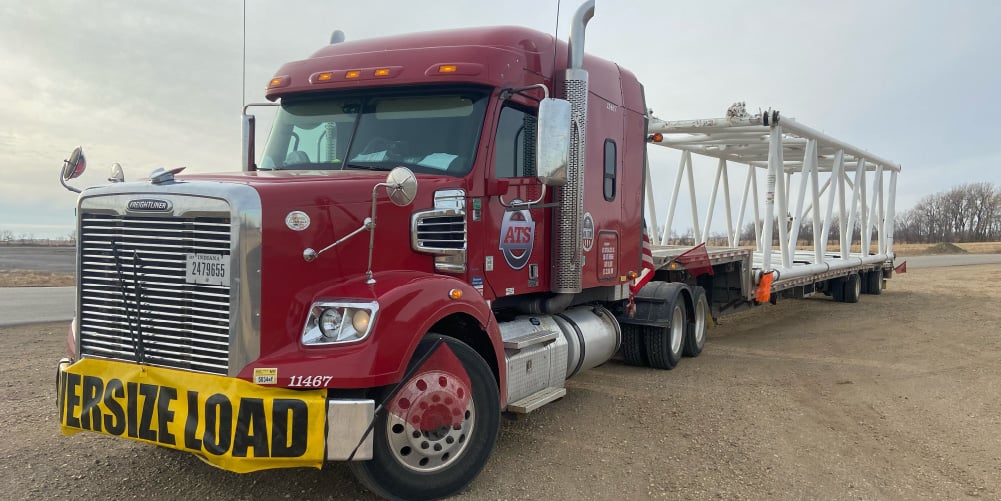
Picture this: you’re driving down the highway, hauling your flatbed trailer with construction goods behind you, when you see a massive wind turbine blade coming down the road.
I want to do that, you think to yourself.
You look in your rearview mirror and see the construction materials safely secured on the trailer.
You sigh.
Flatbed is great and all, but you’re ready to move into the big league. That’s right, you’re ready to haul oversized, over-dimensional loads. You want to haul nineteen-axle loads. You want a pilot car escort to help you pass safely through town. You want everyone’s heads to turn when they see you coming down the road.
You want to be a heavy haul driver.
Does this sound familiar at all?
I’ve worked in heavy haul since 1979, and this is one of the questions I heard the most from flatbed and specialized drivers. And I can’t blame those drivers for asking the question — or for you, the reader, asking yourself the same question right now.
If you want to advance your career, you need to first learn how you can advance your career. Then you need the tools to do it, and then you can begin laying out your plan for advancement — complete with timelines to keep your progress in check.
Otherwise, you’ll end up like Inaction Jackson in the scenario above who simply dreams about what his trucking career could look like, rather than going after it like Heavy Haul Hank.
Let me be clear: There’s absolutely nothing wrong with working as a flatbed or specialized driver. Or even a dry van driver! All of these drivers are needed and they’re all equally important in acting as the lifeblood of our economy. But some drivers have the unique mindset and set of skills required to haul very large, very heavy equipment — and that’s all they can think about.
So if you’d rather be like the Heavy Haul Hanks of the road, keep reading. I’ll let you in on the (not-so-secret) steps you need to take to move up in your trucking career to heavy-haul driving. This includes getting the proper endorsements, investing in additional training and keeping your safety record squeaky clean.
Work Your Way Up
Becoming a heavy haul driver definitely comes with an element of prestige (just ask the drivers who haul rockets to their launchpads).
But drivers don’t get there without a lot of hard work, dedication and patience.
Lots and lots of patience.
You don’t become a heavy haul driver overnight. You don’t just decide one day that you want to haul a wind turbine blade or oil rig equipment, talk to your dispatcher and have them put you on the load the next day. It can be a long process.
For some drivers, it may take as little as a year. For others, it may take five years. It all depends on where you are in your career and whether or not you have a preference for hauling oversized freight (and the skill to do so).
Trucking carriers will typically want to see at least three years of specialized work hauling over-dimensional freight — especially freight that is hauled on a removable gooseneck trailer (RGN) or heavy machinery that the driver needs to drive on and off the trailer themself.
If you take an interest in hauling specialized freight and you excel at it, your dispatcher will take notice. If they think you have the expertise and the safety record to move to heavy haul, they’ll approach you to discuss your desire to move up in classes to haul larger trailers and larger freight. If you're interested and your dispatcher has not said anything, take the step to make sure they are aware that is your goal.
Many carriers will follow a specific structure for moving you up through freight classes. For instance, a driver at ATS may move from a Class 4, to a Class 3, to a Class 2, to a Class 1, to a Class 1A before you can begin heavy haul driving as a Class 8 driver.
Each of these classes allows you to haul a load that is slightly heavier, wider, taller and longer. As you move through these classes, you’ll be tested on your safety performance and your ability to follow curfews, stay on route and secure the proper permits. As long as you have the desire to move up and you meet your carrier’s expectations, you will keep moving up in classes.
Once you reach true heavy haul with a Class 8 license, you will go from a three-axle tractor to a four-axle tractor. As a Class 1A driver, you may only be hauling freight that is over-dimensional in one area — for instance, length. But once you get to heavy haul, you’ll be maxing out not just in dimensions, but in weight. That’s when the four-axle tractor becomes necessary.
Earn Additional Endorsements
You’ll need additional endorsements on your license to work as a heavy haul driver. Heavy haul drivers need a doubles and triples T endorsement in order to haul more axles and double- and triple-trailer trucks.
Endorsements are received at the state level and each state will have different testing requirements.
Attend Heavy-Haul Driver Class
Once you move from specialized (Class 1A license) to true heavy haul (Class 6), you’ll go through heavy haul class. The more pivot points and axles you have, the more training is required.
You will go through heavy haul training school, including an introduction to the larger chains you’ll need to use to secure your freight. You’ll talk about the tractor, the jeep, the trailer and the booster and how they’re connected and disconnected. You’ll run through how to put a deck in a multi-axle trailer. You’ll talk about pivot points and your turning radius. You’ll talk about pilot cars and escorts and when you need them.
You’ll also talk about permits and curfews so you’re always legal while you drive.
To give you some perspective, when you go from being a van driver to a flatbed driver, you typically only go through one day of securement training. Heavy haul training may last from one to three weeks.
All of these teachings will be put into practice before you can get on the road as a heavy hauler. You’ll work with the safety department out in the field where you’ll have the opportunity to put your training into practice and ask any questions you may have.
Your carrier wants you to succeed, not to fail. If they don’t think you’re ready to move to heavy haul, they won’t let you.
Start Small and Keep it Safe
As I mentioned before, you have to be willing to work your way up and start small.
When you first enter heavy haul, you won’t automatically move up to hauling a nineteen-axle load. You’ll be hauling a lot of three-axle RGNs or three-axle step decks.
When you show success, you’ll get to keep adding axles. Just like you do on the specialized side, you will likely move from class to class — from Class 8 all the way up to Class 19, where you can haul nineteen axles.
You’ll continue to have more training and testing as more axles are added and you’re introduced to different vehicle combinations. You may decide that you don’t want to keep moving up, and that you’re happy to haul seven axles. And that’s just fine; we need those drivers out on the roads, too.
As you work up in steps, you’ll be closely monitored and you’ll need to maintain a great safety record. A stellar safety score is absolutely critical.
You get to haul a lot of really cool freight and you make a lot of money doing it, but you earn every dime. Don’t become a Billy Big Rigger and get cocky about your position. When you get cocky, mistakes happen.
How Can I Be Successful as a Heavy Haul Driver?
It takes a special kind of driver to work in heavy haul. Yes, it comes with prestige because you are hauling massive freight and making a lot of money, but it comes with a lot of risks. There’s a much higher potential for something bad to happen if you don’t have your head in the game.
If you’re a driver that loves to haul one load and quickly move on to the next, heavy haul probably isn’t for you. It’s a slow process. You don’t quickly hop from one load to the next. You need to be a patient driver who is willing to take it slow — sometimes very slow — on the road to ensure you deliver freight safely.
Sometimes your loads are so low to the ground that you have to worry about every corner and every bump in the road. Sometimes you’ll need an escort to help you turn. Your pilot car may hit something ahead of you with one of their poles that corresponds to the dimensions of your load, and you’ll have to stop and re-measure your load to ensure you don’t hit anything. Urban settings are very stressful with the additional traffic. It is a very mentally taxing job.
You’ll also need to work inside curfews that are set for each major city. Curfews are set to prevent heavy haul drivers from passing through during rush hour traffic and slowing down traffic even more. They’re also set to prevent drivers from being out at night, where it may be difficult for other motorists to see the oversized load or for the heavy haul driver to see other motorists.
That means you need to really take advantage of your daylight hours. It may take you longer to deliver loads than you’re used to with flatbed, but that’s what it takes to be a heavy hauler.
Not only will you need to be aware of curfews, but you’ll also need to order a permit for every state you’ll be traveling through. When a customer gives you a load, they’ll send you the weight and dimensions of the load. You’ll need to double-check to make sure the dimensions are correct and then you’ll send them into your permit department so they can get you the permits you need.
Get in the habit of measuring every load before it’s even on the trailer to ensure accurate measurements. Doing this can prevent a lot of safety accidents on the road.
Without a permit, you may be fined and you and your trucking carrier are liable. If you get into an accident without a permit, you can get slapped with a lawsuit. Permits and curfews keep all motorists safe on the roads.
Trip planning is crucial as a truck driver, but it’s even more important as a heavy hauler. Failing to plan your routes — and take curfews into account — can set you back for days.
Consider this: You have to go through Memphis, Tennessee. If their curfew is from 4 p.m. to 9 a.m. and you miss that window of drive time, you could be stuck for hours. Another driver that planned and was efficient with their time could be on to the next city while you’re stuck waiting to get through Memphis.
You should always know which road you’re going on; guessing can make for massive, deadly mistakes. Never assume it’s the right road — know that it is.
Sometimes your permits won’t even allow you to go to certain states and you’ll have to route around a whole state. In this case, going down the wrong road and into a certain state by accident could cause you to lose your license.
If you don’t pay attention to curfews and permits and you don’t route plan, you likely will not progress in heavy haul.
Keep On Trucking!
By now, you know that heavy haul driving takes a very specific kind of driver. You should be patient and you should be willing to take it slow, plan, regularly check your loads, get your permits in line and follow curfews.
You should have a clear plan now that will help you move up from your current position to heavy haul driving.
Be willing to take your time as you move up. You won’t be moving multi-axles overnight.


